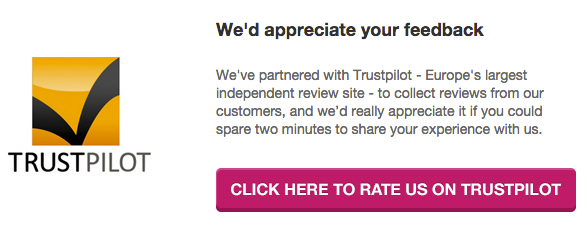Businesses work hard to optimise their websites so that they rise to the top of the Google search results.
Wise webmasters also regularly check where their sites rank over time because, as algorithms change and competitors redouble their own efforts, today’s number-one spot is not guaranteed the same positioning in a week’s time.
Ranking highly for a brand name is especially important for businesses that want to make it easy for customers to find them.
[Tweet “How to Outrank Bad Reviews on the First Page of Google…”].When somebody searches for your professional name, you want your website or – at the very least – a key social media presence to be in the number-one position.
So what if, instead, a negative review of your brand suddenly takes pride of place at the top of the Google results? How can you outrank it to restore your business’s reputation?
We’ve come up with a 10-step plan to outrank bad reviews on the first page of Google.
Related: How reviews boost local SEO
1. Don’t panic
It might feel like a crisis but, in reality, nobody expects a business to be 100% perfect.
We also know that unhappy customers are far more likely to write a review than those who have had a good experience, so the odd negative review is almost inevitable in many industries.
2. Be honest with yourself
Is there any truth in the complaint that has been made? Is it possible that your products or services are not as good as they could be?
If there are issues within your business that need to be resolved, prioritise fixing them.
If you ignore a problem, chances are there will be more and more negative reviews to come, which will make restoring your online reputation a much more difficult and complex task.
3. Encourage positive reviews
One way to reduce the impact of a negative review is to outnumber it with examples of glowing feedback!
Don’t ever be tempted to buy fake reviews from disreputable websites. Instead, reach out to your happy customers and invite them to leave a review about your brand.
You may want to suggest they leave these reviews on third-party sites that are relevant to your industry, such as TripAdvisor or Yelp.
Alternatively, you could ask your customers to submit their reviews to you directly and you could dedicate a section of your website to those comments.

At LCN.com we ask customers, via email, if they would like to review us after a purchase
Encourage positive reviews with our beginner’s guide.
4. Promote the positive third-party reviews you’ve already got
If you have great reviews on third-party websites, make sure everybody knows about them! Screencap the best ones, link to them on social media and publicise and link to them on your website.
5. Use on-site optimisation
If the negative review you want to outrank shows up in searches for your brand name, or your brand name and the word “review”, focus on strengthening your own website’s ranking for these terms.
Create content (or re-work existing content) and promote it with on-site optimisation tactics.
This includes making sure that the keywords you are targeting are contained in the H1 tags, the main page’s content, and in the URL and title tags, too.

This is a great opportunity to create a customer review / testimonial page on your website to encourage potential customers to complete a purchase.
For more information on on-site SEO optimisation check out our guide.
6. Produce content for other websites
Outranking negative reviews is often a numbers game. If your brand’s website is at number one in the search results, your Twitter account is number two, and the critical review is at number three, further strengthening the first two will only have a limited effect.
Instead, focus on getting more content out there, on different websites, to outrank the criticism.
Seek a guest blog post spot with Huffington Post, write an in-depth article on Medium, or offer to write guest posts for prominent websites within your industry.
7. Maximise your social presence
It is not unusual for Google searches to return a brand’s social networking accounts in the top ten results, especially if they are active.
Make sure you have claimed your brand’s social media profiles on Twitter, Facebook, LinkedIn, Google+, Pinterest, YouTube and Instagram, at the minimum.
Do you also have a Tumblr account? Do you create a podcast? Make the most of all these social-media accounts by using them regularly and linking to them on your website and in your email marketing.
If you feel stuck, consider using services like Knowem? to claim all the social-media profiles you could use to secure your brand name.
8. Create some YouTube videos
YouTube videos often show up in the first few pages of Google search results, so creating a video with your business name in the title and tags has a decent chance of ranking when customers search for your brand.
Don’t feel intimidated by the prospect of beginning video marketing; it needn’t be a massive undertaking, given that most phones and laptops now offer simple video-making capabilities. Don’t overthink it!
To identify what type of video your company could create, take a look at run down of the 5 YouTube videos every business needs.
9. Make news
Do, create, or research something incredible, then create a high-quality press release and send it out to local media, as well as relevant national or industry publications with an online presence.
If what you have done, created or researched is incredible enough, and your press release showcases it well, the media attention you could gain can outrank the negative review within days.
This could also get you a few very valuable backlinks from high quality sources if you make national news!
10. Don’t accidentally make it worse
By regularly searching for ‘brand name + scam’ or ‘brand name + ripoff report’, you could persuade Google that it is a relevant search that should show up in their autocomplete or ‘related searches’ when someone searches for your brand!
Things may not exactly work like this but it’s safe to say Google record all searches and they surely must have some influence (no matter how many) on their algorithm and autocomplete service.
Similarly, don’t keep searching for your brand and clicking on the negative search result – as once again, it’s very possible that click-through rates are a ranking factor.
Your Say!
How do you deal with bad reviews outranking your positives ones, or even your site! As how do you react to seeing high ranking bad reviews as a customer? Leave us a comment.

2 thoughts on “How to Outrank Bad Reviews on the First Page of Google”
Comments are closed.